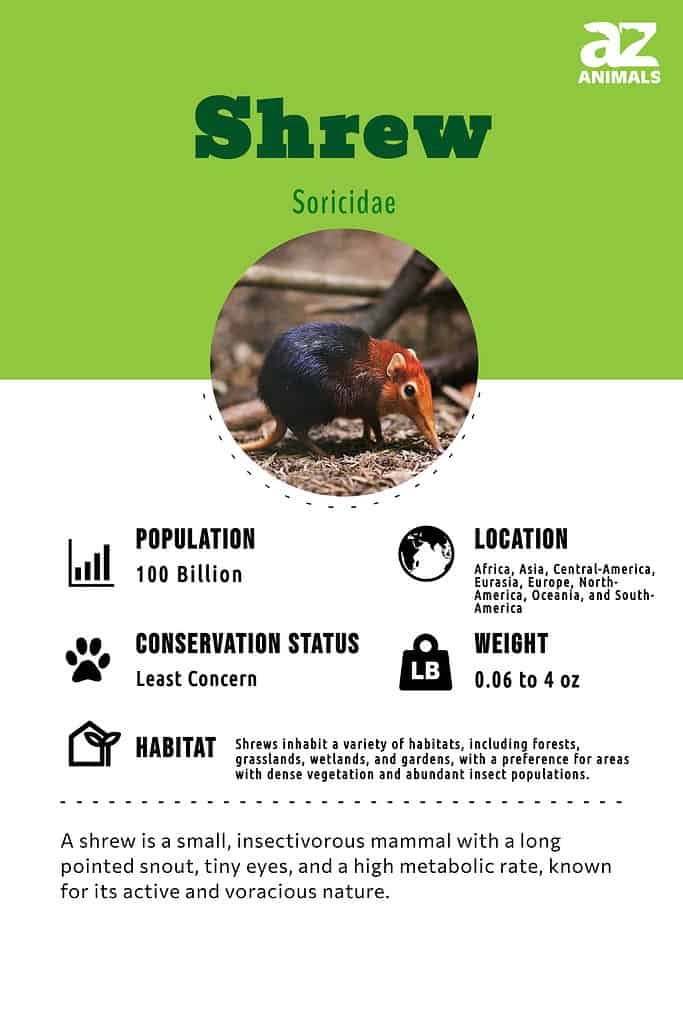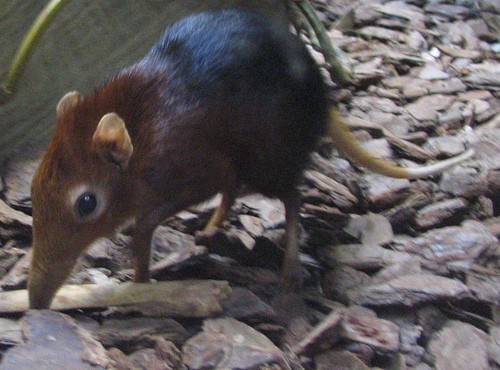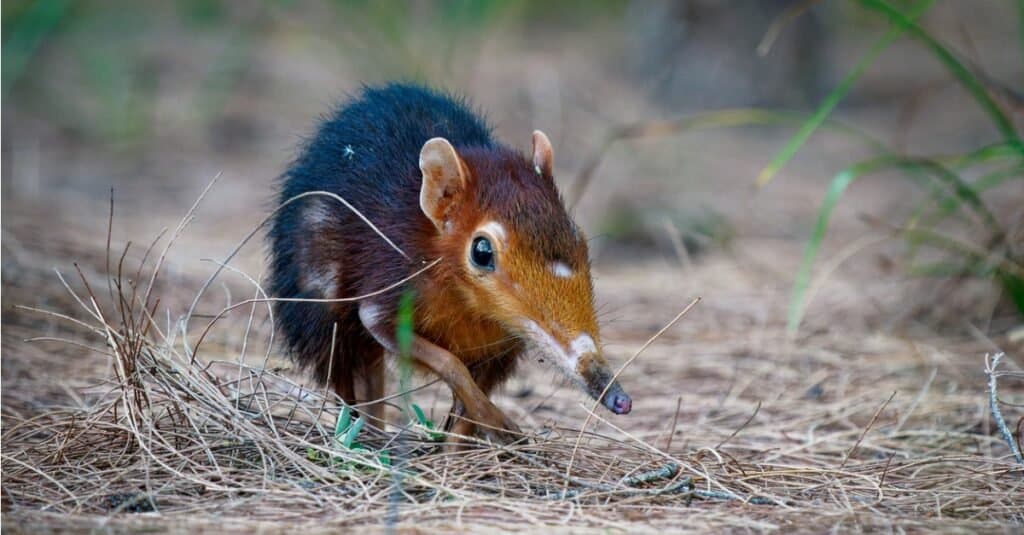Shrew
The spinal column of the shrew Scutisorex somereni is so strong and reinforced that it can support the weight of an adult human.
Advertisement
Shrew Scientific Classification
Read our Complete Guide to Classification of Animals.
Shrew Conservation Status
Shrew Facts
- Prey
- Insects and other small invertebrates, small aquatic animals
- Name Of Young
- Baby, Juvenile
- Group Behavior
- Solitary
- Fun Fact
- The spinal column of the shrew Scutisorex somereni is so strong and reinforced that it can support the weight of an adult human.
- Estimated Population Size
- 100 billion, conservation status least concern
- Biggest Threat
- Habitat destruction, climate change, pollution
- Most Distinctive Feature
- Its bad smell
- Gestation Period
- 18 to 27 days
- Litter Size
- Two to 10 babies
- Habitat
- Gardens, burrows, near small bodies of water in temperate, subtropical and tropical climates
- Predators
- Birds of prey, snakes, pet cats, foxes, weasels
- Diet
- Omnivore
- Type
- Mammal
- Common Name
- Shrew
- Number Of Species
- 384
- Location
- North, South and Central America, Asia, Africa, northern Europe
Shrew Physical Characteristics
- Color
- Brown
- Grey
- Black
- Skin Type
- Fur
- Top Speed
- 8 mph
- Lifespan
- 12 to 30 months
- Weight
- 0.06 to 4 ounces
- Length
- 1.4 to 6 inches
- Age of Sexual Maturity
- 3 to 52 weeks
- Age of Weaning
- 5 to 6 weeks

The motto of the Shrew can truly be “Live fast, die young.”
Frankly, shrews are a bit weird. They are tiny, with the Etruscan shrew being only 1.375 inches long, making it the smallest land mammal on Earth. Because of that small size, these insectivores must constantly eat.
If one doesn’t eat even for a few hours, it dies of starvation. Even with their unquenchable appetites, members of the Soricidae family seldom live past three years.
Some, such as the Anourosorex schmidi, are venomous, another unusual characteristic when it comes to mammals. Their bones are so small and frail that they don’t fossilize well, so the historical record of the animal is scant.
Yet there’s a creature called the hero shrew that can support the weight of a grown man standing on its back. Read on for more information about these astonishing animals.
Four Incredible Shrew Facts!

Creatures belonging to the Sorex and Blarina genera employ echolocation not for locating prey, but as a means of navigation.
©Joey Makalintal / Creative Commons – Original
Here are some amazing facts about this tiny but powerful animal:
- Animals in the Sorex and Blarina genera use echolocation. They don’t use it to find prey but to navigate.
- Their teeth are sometimes red because of the iron in their enamel. This strengthens the teeth, which are used more often than other mammals use theirs.
- They routinely eat one-half to three times their own body weight every day.
- Females can give birth 10 times a year. Depending on the species, each litter can have four to 10 babies.
Scientific Name

These insectivorous mammals are members of the Soricidae family, derived from the term “sorex,” which is the Latin word for “shrew or shrew-mouse.”
©Brent and MariLynn / Creative Commons – Original
These insectivores belong to the Soricidae family. Soricidae comes from the word sorex, which is simply Latin for “shrew or shrew-mouse.”
Within this family are 23 or 26 genera and 385 species.
There are also many semispecies and subspecies.
For example, Blarina brevicauda has 11 subspecies which are in turn placed in two semispecies, Blarina brevicauda brevicauda, and Blarina brevicauda talpoides:
- Sorex palustris brooksi
- Sorex ornatus relictus
- Sorex ornatus sinuosus
- Sorex ornatus salarius
- Tule shrew
- Sorex longirostris fisheri
- Sorex vagrans halicoetes
- Sorex ornatus salicornicus
- Sorex arcticus laricorum
- Sorex arcticus arcticus
- Sorex ornatus lagunae
- Sorex palustris navigator
- Sorex palustris punctulatus
- Sorex shinto shikokensis
- Sorex fumeus fumeus
- Sorex fumeus umbrosus
- Sorex shinto shinto
Evolution and Origins
Approximately 2.7 million years ago, shrews initiated a process of diversification in Eurasia, subsequently undertaking migration to North America on at least two separate occasions.
The evolution of shrews was influenced by the cyclical glacial and interglacial periods of the Pleistocene era, resulting in heightened rates of speciation and the emergence of novel lineages.
The evolutionary lineage of shrews dates back to the Middle Eocene Epoch, spanning from 48 to 41.3 million years ago, primarily in North America, with subsequent fossil discoveries indicating their presence in Africa, Asia, Europe, and South America.
Furthermore, it is believed that the earliest primates can trace their ancestry back to a small, insect-eating mammal that was likely nocturnal. Among the living relatives of primates, tree shrews and colugos (also known as flying lemurs) are considered to be the closest.
The tree shrew serves as a valuable model for studying the characteristics and behaviors of early primates or primate ancestors.
Appearance
The shrew is a tiny animal, and even the largest, Suncus murinus does not grow more than 6 inches in length or weigh much more than 4 ounces. They are covered with gray, brown, or black fur on the top and sides, though their ventral areas are paler.
Their skulls are long, narrow, and flat, and their noses are pointed. Their eyes are tiny, sometimes to the point of being vestigial. Because of this, biologists believe that they sense the world through hearing, smell, and touch. Some species actually use echolocation, much like bats.
The shrew’s teeth are not replaced throughout the animal’s admittedly short lifespan, and one of the weirder facts about the animal is that it loses its baby teeth before it’s even born.
Many characteristics set these insectivores apart from other mammals, and one of them is their extreme metabolic rate. Basically, the shrew must eat pretty much all the time, day and night. Its pointed nose helps it dig underground in search of worms and grubs. Some members of the Soricidae family live around water, are excellent swimmers, and live on a diet of aquatic animals.
They don’t hibernate but can go into torpor, where their metabolic rate slows but not as drastically as it would in hibernation. During cold months when food is not plentiful, a shrew can lose as much as half of its normal body weight. It not only loses fat and muscle but its bones, skull, and viscera actually shrink.
Shrew vs Mouse

©iStock.com/phototrip
Many people mistake a shrew for a mouse, which is understandable as they are both small, furry, neutral-colored animals. But the two are not closely related and there are important differences in identification between them. One aid in the identification of a mouse is to look at its teeth. A mouse is a rodent with incisors meant to gnaw.
These teeth grow throughout the life of the mouse, so gnawing is essential. The teeth of the shrew only wear down over time. Indeed, its teeth are often red because the iron in the enamel has been revealed. Venomous members of the Soricidae family deliver the venom through grooves in their teeth. Mice are not venomous.
Overall, members of the Soricidae family tend to be smaller even than mice. The eyes of a shrew are also tiny, while the eyes of a mouse can be huge in proportion to its head and give it an overall cuteness. Those eyes also give a mouse excellent vision.
Shrews also have small ears while the ears of mice are large. The food they eat can also be compared. Though anyone who has had a mouse in the house knows it will eat just about anything including the corpses of its conspecifics, scientists identify shrews as insectivores. The main diet of mice is supposed to be seeds, nuts, and other plant materials.
Mice have long tails, and though some members of the Soricidae family have long tails, others like those in the Brevicauda genus have short tails. The shrew’s tail also has more fur than a mouse’s tail. The front feet of members of the Soricidae family have five toes while the front feet of mice have four. Another method of shrew identification is to use your nose. Shrews smell like skunks. Mice may not smell sweet, but they are not nearly as pungent as shrews.
Mice are largely social animals, while shrews are territorial and solitary. A couple of exceptions to this may be Anourosorex squamipes, as one study showed several individuals living in the same burrow. Suncus etruscus may even be monogamous. Generally, outside of the mating season, a shrew will attack another shrew that comes into its territory.
Behavior
Because they have to eat so much to maintain their metabolism, members of the Soricidae family are on the hunt for food day and night and only stop for brief rest periods. Most prefer moist habitats where it is easy to dig through the soil to find insects and invertebrates. Others live among vines or in bushes or small trees.
They also take over the burrows of the fossorial animals, and some, such members of the Anourosorex genus, spend most of their time underground. Sorex palustris dens on land but hunts in the water. Some of these animals have the ability to run on water due to the ability of hairs between their toes to trap air bubbles.
Habitat
They are found in temperate and tropical areas all around the world. Only New Zealand, Australia, and New Guinea lack native shrews. They prefer deciduous woods, evergreen and deciduous forests, grasslands, hedgerows, gardens, and areas near bodies of water that can provide enough food.
Diet
These insectivores eat beetles, bugs, earthworms, grubs, spiders, millipedes, small fish, frogs, caterpillars, and other insect larvae. Other food items are mollusks, moths, flies, woodlice, fungi, and vegetation.
Predators and Threats
Animals that prey on members of the Soricidae family include birds of prey such as owls, weasels, foxes, and snakes. Though they are abundant, they are sensitive to changes in their environment such as pollution or habitat disruption.
Reproduction and Life Cycle
Members of the Soricidae family breed in all seasons save winter, and their babies are born in spring or summer. Males sometimes court females by making clicking sounds. Females mate with several males and each litter may have more than one father. On the other hand, males also mate with more than one female. The majority of males do not give parental care, and females raise their babies by themselves.
Females are pregnant for 18 to 27 days and can give birth to between two and 10 babies at a time. Babies are born blind, naked, and helpless and have already shed their baby teeth in the womb. They’re nursed for a little over a month in general.
Sometimes when the mother needs to move her young the family will form a caravan where each baby holds the tail of the other as they follow her. Some members of the Soricidae family are ready to reproduce themselves when they’re only three weeks old, while others aren’t ready to breed till they are a year old.
Population
The Soricidae family is one of the most species on earth, with 385 species. Only mice, rats, and Vespertilionidae bats have more species. Biologists believe that there are about 100 billion types of shrews on earth, and their conservation status is least concern.
View all 293 animals that start with SShrew FAQs (Frequently Asked Questions)
Are Shrews carnivores, herbivores, or omnivores?
Members of the Soricidae family are omnivores but they are placed in the Insectivora order, as much of their food consists of insects and other small invertebrates.
What is a shrew?
It is a tiny mammal, even smaller than a mouse, that is found in most places on earth.
What does a shrew look like?
It is a very small mammal with thick gray, brown, or black fur. It has tiny eyes and ears and a long snout that helps it dig. Depending on the species, the tail can be long or short.
How big is a shrew?
It is between 1.4 to 6 inches long and weighs 0.06 to 4 ounces.
Do shrews eat humans?
They do not eat humans. The venom of even venomous members of the Soricidae family is harmless to a human.
Are shrews good or bad?
Generally, they are good. Grains and cereals are not a mainstay of their diet the way they are for mice, and they can indeed keep the mouse population under control. If a person comes across a dead mouse with its skull cracked open and its brains are eaten, that was probably the work of a shrew. They also eat insect pests and are prey for larger animals.
Do shrews bite humans?
They can bite humans if they object to being handled, but the bite is harmless if a bit painful.
Where do you find shrews?
Members of the Soricidae family are found in the warmer areas of the world. They often den in gardens, orchards, pastures, woods, forests, grasslands, and near streams.
What's the difference between shrews and moles?
There are many differences between moles and shrews. Moles grow much larger than shrews do, and they spend their entire lives underground, while shrews enjoy living above ground.
Thank you for reading! Have some feedback for us? Contact the AZ Animals editorial team.
Sources
- Maryland Department of Natural Resources / Accessed January 13, 2022
- Wikipedia / Accessed January 13, 2022
- ITIS / Accessed January 13, 2022
- Pets on Mom / Accessed January 13, 2022
- Britannica / Accessed January 13, 2022
- Northwoods Star Journal / Accessed January 13, 2022
- Science Direct / Accessed January 13, 2022


















